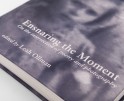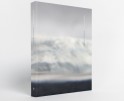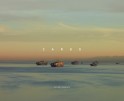ART+SCIENCE: Gerco de Ruijter
Dutch photographer Gerco de Ruijter is a visual artist with a focus on aerial landscape photography and film. Through his work, he explores the boundaries of landscape photography, shedding light on the processes that cause change, including human interaction and the natural changes of the environment over time. In the photography series entitled Cropped, de Ruijter uses Google Earth as a source to scan aerial views of center-pivot irrigation plots within the American Southwest. Although the subject matter is recognizable as a landform, it is transformed into a surreal abstraction. These photographs are connected by geometry, the circular images inherent of irrigation plots. Yet, the subject matter is made distinct by the evolution of both manmade and natural forces upon the land.
Crops (Gerco de Ruijter) from Michel Banabila on Vimeo.
Gerco de Ruijter (1961, Vianen) is a visual artist who works with photography and film. He mostly uses kites, balloons and fishing poles to create images of situations far from our own point of view. In his artwork he explores the boundaries of the recognizable and reducible presentation of landscapes.
De Ruijter studied at the Willem de Kooning Academie in Rotterdam, and graduated Cum Laude in 1993. Since then he has had numerous solo and group exhibitions both within and outside of the Netherlands. His work is also included in several important private and public collections. In 2016, a book on de Ruijter and this series of works entitled ALMOST NATURE was published by Timmer Art Books / Lecturis 2015.
Cropped
Since the late 1980s I have sent cameras into the sky with the aid of kites. I have always pointed my cameras straight down in order to abstract a certain piece of landscape. These formal images, with their rigid framing and unusual viewpoint, raise questions with regards to scale and dimension, as well as doubt: what am I looking at? They have no inherent up or down, there is no portrait or landscape position. They give us the opportunity to rotate and mirror an image in steps of 90 degrees.*
I had seen images of circular irrigation fields and was immediately drawn to them by their minimal , yet, hard edged abstraction: the brown desert landscape and floating in it these bright green color “patches.”*
During my first visit to the USA in 2003 I tried to photograph these irrigation circles with my kites and cameras in Farmington, New Mexico, only to discover that their scale was much too large. Even with a panoramic camera I could only capture a small part of the circle.
From the ground, standing between these circles, you barely notice the circular shape. They are just too big. It looks like boring agricultural land, the same as the rectangular wheat and potato fields elsewhere in Europe, only bigger.*
The surprise is that the “magic” only happens while seeing them from space. From Google Earth the scale of the fields has been brought down and at the same time the human remnants, the “John Deere” machinery is erased in this (perspective-driven) quantum leap…*
*(Excerpts from an interview with the artist by Kelly Gordon Margolis curator at the Hirshhorn Museum and Sculpture Garden Washington DC, 2014)
Posts on Lenscratch may not be reproduced without the permission of the Lenscratch staff and the photographer.
Recommended
-
Linda Foard Roberts: LamentNovember 25th, 2025
-
Leah Ollman: Ensnaring the MomentNovember 2nd, 2025
-
Tristan Duke: Glacial OpticsAugust 1st, 2025
-
Richard Misrach: CargoJune 8th, 2025
-
James Stanford: The Atomic KidMarch 19th, 2025




























































